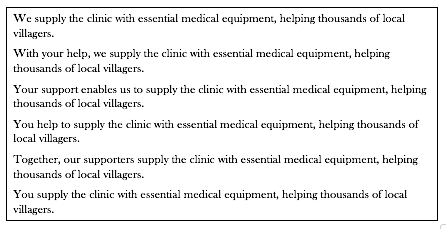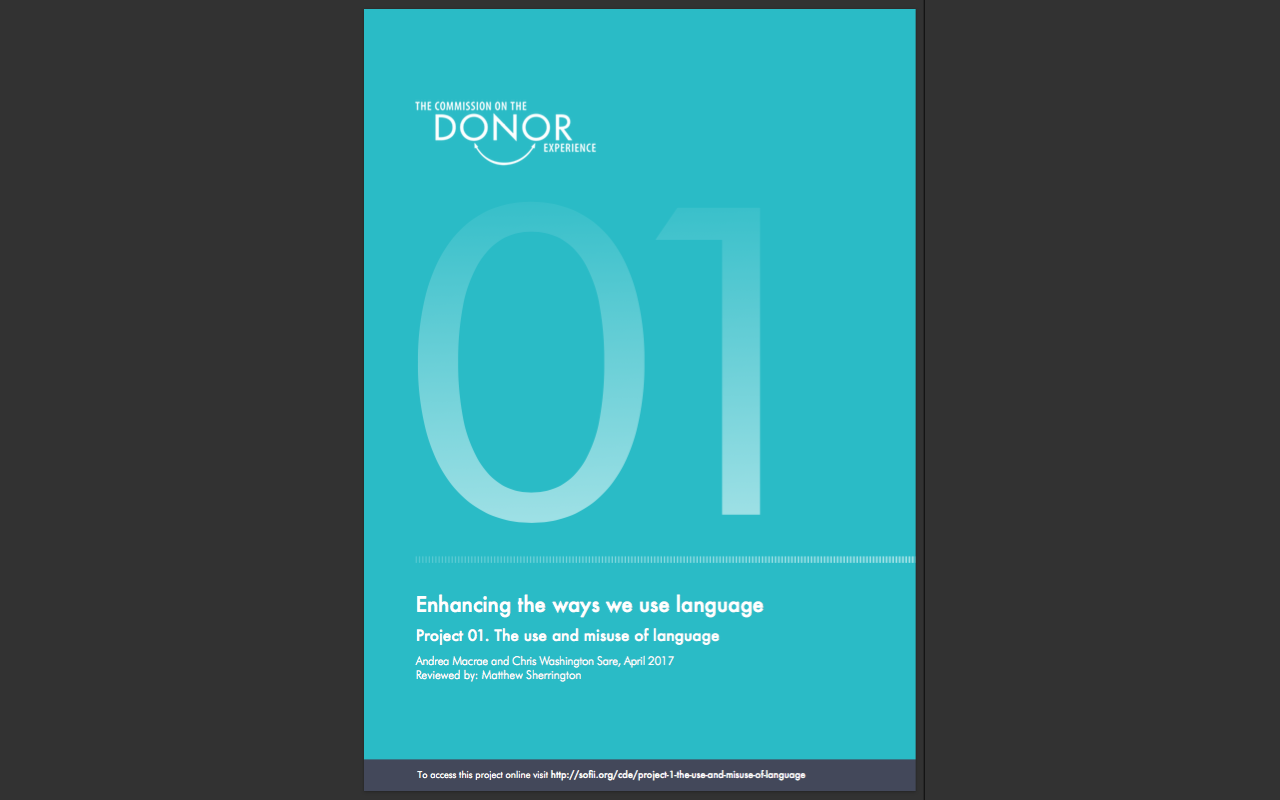CDE project 1 section 2: talk less about the charity and more about the cause, the work, the beneficiaries and the supporters
- Written by
- The Commission on the Donor Experience
- Added
- April 30, 2017
Enhancing the ways we use language
CDE Project 1: The use and misuse of language
Andrea Macrae and Chris Washington Sare, April 2017
Reviewed by Matthew Sherrington
2. Talk less about the charity and more about the cause, the work, the beneficiaries and the supporters.
Many charities have found that supporters prefer messages from individual beneficiaries, or individual workers at the forefront of the impact (a clinician or nurse, a refugee centre manager, etc.) in comparison to messages from whole organisations or senior managerial figures (e.g. a Head of Humanitarian Support). Named, and ideally pictured, people who are most directly involved in delivering solutions to beneficiaries show the ‘human face’ of the work of the charity and provide readers with an identifiable connection. Hearing from someone with first-hand experience of the issues can create more real and more powerful insights and experiences for the supporters, offering a window onto the difference they can make. It is usually the cause that a supporter cares about; the organisation is secondary, chosen as a means of helping to address that cause, as suggested by evidence gathered in a study by Sargeant and Lee (2004).[1] In the same study, supporters strongly reported that the beneficiaries were very important to them. [2] It makes sense, then, for supporters to primarily hear from people at the heart of the issues and the impact.

Just as many supporters want to hear directly from people at the front-line, many also say in surveys that they want to hear about the difference they are making, and that this enhances their trust in the charity. [1] The Narrative Project (funded by Arthritis Research UK, MS Society, the NCVO and CharityComms, 2015/16) found, through focus groups, that emphasising the impact and agency of the supporter is really important to the supporter-charity relationship.[2] Compare the following:
[1] See Sargeant, A. (2016), Relationship fundraising: Where do we go from here? Vol. 1 – Review of theory from relationship marketing. Plymouth: Centre for Sustainable Philanthropy, Plymouth University: see p. 10 particularly.
[2] For more information on the Narrative Project, see http://blogs.ncvo.org.uk/2016/...
[3] See Sargeant, A. & Lee, A. (2004), ‘Improving public trust in the voluntary sector: An empirical analysis’, International Journal of Nonprofit and Voluntary Sector Marketing, vol. 7, issue 1, pp. 68-83: see p. 73 particularly.
[4] See p. 76 of the same article.

The sentences progressively shift from putting the emphasis on the organisation’s actions to focusing on the supporter’s role and showing supporters the direct impact they are having.
Likewise, different kinds of thank you messages can seem to prioritise and emphasise the role of the organisation over the supporter. Think about the differences between the sentences “We want to say thank you.” and “Thank you.” The first sentence puts ‘we’, the anonymous staff at the organisation, first, both in terms of word order and emphasis, swiftly followed by what we ‘want’, stressing the desires of the organisation. The actual words ‘thank you’ trail along behind the organisation and its wants. It’s a subtle effect, but the act of thanking is accidentally backgrounded, along with, in contrast, what the supporter might want (for example, to get different kinds of messages, or indeed not to be contacted). The potency of the ‘thank you’ is dramatically dulled.
Word order is more significant than it may seem. There is a lot of linguistic data, gathered over several decades of research, which proves that word order powerfully influences what a reader will pay attention to, take in, and remember. [4] While it is important to foreground the role of the organisation in some situations, it is always worth checking communications for what might be called inappropriate organisational egocentricity. In other words, where possible, stay out of the spotlight, and focus it on what supporters most want to see.
To illustrate the issue a little more, here is some sample copy, combining real sentences from two Christmas appeal letters, each of which involved a degree of inappropriate organisational egocentricity. The examples have been combined to provide a realistic sample without making reference to specific organisations.
[4] See empirical research summarised and developed in Sanford, A. J, & Emmott, C. (2012), Mind, brain and narrative. Cambridge: Cambridge University Press, especially chapters 4, ‘Attention in text: Foregrounding and rhetorical focussing’, and 5, ‘Rhetorical focussing and depth of processing’, pp. 72-131.

In the first two sentences of this copy, the organisation is foregrounded – it’s presented as the main ‘doer’ of good and even as the immediate receiver of the ‘gift’. The purpose of the second sentence seems partly to be to explain and justify the ‘ask’, but its phrasing puts the primary emphasis on the actions of the organisation. Only in the third sentence do the people at the heart of the cause – the beneficiaries - really come to the fore. The ‘we’ at the end of the fourth sentence could also include both the organisation and the supporters, giving some suggestion of the effect the supporter can have with the organisation, but the supporter’s role and impact could be expressed and emphasised much more clearly. This version of the copy seems to imply that the organisation will be acting with or without the supporter. The supporter may feel less of a sense of urgency, as well as less of a hope of impact, than could otherwise be evoked.
Of course, in some messages and some contexts it is entirely appropriate and more effective to focus on the actions and achievements of the organisation – for example, in parts of reports to trustees. There is no ‘one size fits all’ for communications, even within one organisation, never mind across different organisations. When communicating with supporters, though, and particularly when asking or thanking, foregrounding the cause, the beneficiaries, front-line workers and the role and impact of the supporter seems to be both more desired and more effective. Think of your audience and what they want to know and feel, and keep everything else out of the way.


















